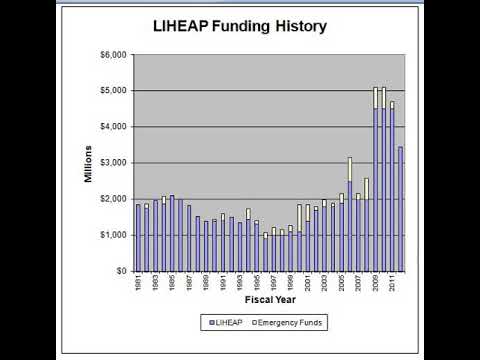The Reduced Income Home Energy Support Program
( LIHEAP) is an USA government social solutions program first established in 1981
and moneyed every year with Legislative appropriations. The objective of LIHEAP is to help low earnings
homes, specifically those with the most affordable earnings that pay a high proportion of home
earnings for home energy, largely in fulfilling their instant home power needs. The program, part of the United States Division
of Health and Person Solutions (HHS), is funded by gives appropriated from the federal government. == Funding circulation ==.
Funding is distributed per of the fifty states, U.S. areas and tribal governments.
via the United States Department of Health And Wellness and Human Being Solutions (HHS). Management of the program is left up to.
state, territorial or tribal federal governments. Congress additionally supplies the President of the.
USA with minimal backup funds annually, which are scheduled for emergency situation.
LIHEAP uses single economic aid. Applicants have to have an earnings less than 150%.
The Low Earnings Home Power. Assistance Program( LIHEAP )provides funding aid to low-income houses, targeting. Block grants, the Residential Energy Assistance Difficulty Program, Backup Finances, and.
Extra funds might be offered in emergency. Last distribution of funds is performed through. Adhering to the objectives and plans of LIHEAP.In most states, the program is run on a.
The Home Energy Support Target( H.E.A.T. )program is the State of Utah ' s program via.
Summit Counties. Numerous state LIHEAP companies likewise supply weatherization.
Periodically, acceptance of the weatherization. procedure is mandatory with authorization for LIHEAP assistance. Some states have actually attempted to establish Percentage. of Revenue Payment( PIP) plans within or along with the traditional LIHEAP block give. model.Although general funding has actually increased since. 2002, future funding might be restricted as a result of the current trend in reducing the spending plan based. on building codes needing power performance, modern-day home appliances with low energy
use standards,. and issues regarding federal budget sustainability. As the program moves on, the spending plan being. reduced along with the rise of applicants are the 2 significant challenges it deals with.== History ==. LIHEAP history started in 1980 when congress developed the
Reduced Earnings Power Help Program. (LIEAP ), as component of the Unrefined Oil Windfall Profits Tax obligation Act to address the issues of. the rising energy costs of the 1970s. In 1981, LIEAP was replaced with LIHEAP as. part of the Omnibus Budget Plan Reconciliation Act. In 1984, the Person Providers Reauthorization. Act added a brand-new goal to provide funds for cooling down expenses of low-income homes.
Congress also required using even more current. population and power data, which implied the moving of funds from solely cold-weather. states to warm-weather states.
In 1988, there was one more significant adjustment where. the National Center for Appropriate Technology( NCAT) started to run the LIHEAP Clearinghouse.== Management==. LIHEAP is provided by the Department of Wellness and Person Providers.
Several federal divisions supply oversight. and direction to the program.
These include the Management for Children. and Family Solutions, the Office of Neighborhood Services, and the Department of Power Help. The National Facility for Appropriate Modern Technology. is an added advisory body in the program before funds are offered to beneficiaries. The federal government does not give LIHEAP. aid to the general public.
Instead, the federal government offers funds. to states, state-recognized or federal Indian tribes, tribal organizations, and insular.
areas to carry out. Teams that receive funds are considered grantees. in the program. LIHEAP grantees have adaptability to layout.
Each state may have varying departments or. Shown above is the program flow from the government.
to neighborhood degree in the State of Utah. In Utah, LIHEAP funding is managed through. the Home Power Help Target( WARM) program, which is managed by the state or Association. of Governments (AOG). The Mountainland AOG offers direct oversight. for help to city government companies in Utah, Wasatch, and Summit Counties. MAG obtains nearly$ 2.5 Million yearly.
State of Illinois has actually introduced in 2014 that.= =Federal funding== LIHEAP is funded by annual appropriations. Management of the program is left up to.
state, territorial or tribal & federal governments. Congress likewise provides the Head of state of the. United States with minimal backup funds annually, which are scheduled for emergency situation. circumstances and released at the Head of state ' s discretion.State legislatures usually supply added. appropriations every year to supplement government LIHEAP funds. === Funding sources===. The quantity of funding readily available for actual help comes from 4 major sources including:. Block grants, the Residential Energy Help Obstacle Program, Backup Funds, and. Leveraging Incentive Programs. The following is a synopsis of just how these resources. tie into LIHEAP.= == Block grants ===. Block gives make up most of dollars distributed for the LIHEAP program. To be approved a block give, states, territories,. Indian people, and tribal companies that wish to aid low-income houses in conference. the costs of home power, may get a LIHEAP block grant. === Residential Power
Aid Obstacle. Program (REACH)= == The Residential Energy Assistance Difficulty. Program( REACH) “offers gives that fund presentation tasks to check numerous techniques. to assist low-income households reduce their power use and become much more
self-sufficient in meeting. their home energy needs.” Local community-based agencies that implement.
ingenious strategies to assist LIHEAP eligible families minimize their energy vulnerability can obtain. these funds. Since 2001, 54 REACH gives had been moneyed. developing an annual spending plan of$ 6
Million, or one half of a one percent of the overall financing. for the LIHEAP program. These grants have been made use of
to develop weatherization.” products, workshops on power efficiency procedures
for homes, budget plan therapy, and. have actually created customer cooperatives to acquire home energy.State tasks compete 3 years, and state. beneficiaries are called for to agreement for third-party analyses and to report after the final thought. of the task on the performance of the strategies that they have tried.=== Contingency funding===.
Backup funds are funds that are released to aid with home energy demands as a result of emergency situation.
Usually, these funds are launched in reaction. In the 1980s, contingency funding was only. In the 1990s, it was used eight times, and.
=== Leveraging Incentive Program===. The Leveraging Motivation Program is developed to compensate those grantees that have actually obtained. == Exactly How LIHEAP and WAP work with each other==.
( WAP )collaborate to aid low-income people and households pay power costs and minimize power. prices. This write-up provides of introduction of each program. and defines just how they collaborate. LIHEAP and WAP literature is also checked out.
Ultimately, an area describing literacy in low-income. consumers is consisted of.=== Overview===. The objective of the Low Income Power Support Program( LIEAP )( likewise called Reduced Revenue. Home Energy Support Program (LIHEAP) ), developed in 1981, is to assist low revenue houses,. specifically those with the most affordable earnings that pay a high proportion of family earnings. for home power, primarily in fulfilling their prompt home power demands. The program, component of the United States Department
. of Health And Wellness and Human Being Provider (DHHS), is moneyed by gives appropriated from the federal government. LIHEAP pays partial winter season power costs for.
qualified people and family members.
Repayments are usually made straight to regional. The payment amount is figured according to. A press launch from the Division of Wellness.
and Human Being Providers on June 5, 2013, shows that $187.4 million was released to states. to assist low-income homeowners and tenants with increasing power costs. This financing supplements $3.065 billion in. grants provided earlier in the year with The Low-Income Home Energy Help.
Program( LIHEAP). The funding offers to aid households pay their. home heating and electrical power
, as well as make weather-related

enhancements to their homes.This aids to protect against these family members from. having solution disturbances. George Shelton, HHS acting aide secretary. for the Management for Children and Households, specified that heats equate right into. high power costs for families who are already struggling to make ends meet.=== Introduction of the Weatherization Assistance.
Program (WAP)=== The United States Weatherization Aid. Program( WAP) was developed in 1976 to help low-income households decrease power usage.
WAP financing is derived from yearly appropriations. Each year, the Senate and Residence Inside Appropriations. WAP specialists execute energy audits on a. home to help situate efficiency problems.
As soon as an audit is complete, the program can. help by insulating windows and walls, replacing damaged glass, and screening, repairing, and/or.
replacing burning appliances.Like the LIHEAP, an individual ' s income degree. must go to or below 150 %of the government hardship level to be eligible for the WAP.
== =WAP ===. LIHEAP and WAP are the keystones of any public energy aid program. Usually, the 2 programs not only function
togetherWith each other.
LIHEAP and WAP are generally found in the very same workplace. XII) are in cost of'LIHEAP and WAP.
Each division supplies a number of other programs. that aid low-income individuals and households with home heating and energy issues.
When a client finishes and transforms in an application. Prior to a client ' s home can be weatherized,. Weatherization actions may include caulking,.
When a home is set up for weatherization. Working with each other to offer power. The program literary works consists of even more than.
Tips consist of replacing light bulbs with small. Financing Trends Congress appropriated $3.47 Billion toward.
the program in 2012. Over the previous years, funding for LIHEAP has.
The President ' s spending plan proposal in 2012 dramatically. The two major factors why the budget plan has actually been. ANNUAL MEASURE FY TARGET OUTCOME 1A.
RISE THE RECIPIENCY TARGETING INDEX RATING. OF LIHEAP HOUSEHOLDS HAVING AT LEAST ONE PARTICIPANT 60 YEARS OR OLDER. LIHEAP effectiveness is monitored on a regular basis via its recipiency targeting index.
An index score over 100 shows that LIHEAP. The table likewise reveals what the actual national. Each December, state LIHEAP beneficiaries are called for.
to report on the LIHEAP Grantee Study the adhering to information for the previous government financial.
year: sources of LIHEAP funds. uses of LIHEAP funds typical house advantages for aid.
Grantee Study are included in the LIHEAP Record to Congress. 2003 LIHEAP and related data are obtained from LIHEAP grantee reports and surveys, nationwide. Power Costs.
While the program administrators use the above actions and records to comprehend exactly how the.
The 2008 spike in funding was required to attend to.
The recent decline in appropriations prior to. 2008 levels might not be enough to take care of the ongoing
climbing of heating home heating prices its.
Not only are fuel rates continuing
to increase, program recipients get on the rise.This might be illustrated in the complying with graph. revealing the increase in homes offered by the program in relationship to the quantity of. LIHEAP funds designated to the State of Utah. Some data of note for the
State of Utah. consist of: SEALworks taped that 1,619 houses were. shut down before coming in for warmth
support HEAT program helped stop 10,243 homes
,. that had closed off notifications, from being shut off.
Nearly $375,769 in normal warm Situation assistance aided 1,373 households in 2011.
The program offered 18,592 families with children in 2011. The program assisted 10,875 elderly households to get HEAT help in 2011. The program helped 17,947 individuals who have impairments in 2011Coordination with Outside. Programs In addition to giving matching funds through. the Leveraging Reward Program, LIHEAP strives to coordinate efforts with exclusive energy. companies and non-profits where government financing is not offered. In the State of Utah, a few of these other.
Questar ' s Energy Aid Fund and REACH program, Catholic Community Providers, American. Red Cross, and Murray
City Relief Alleviation.
=== Financing resources===.=== Backup funding===.
=== Leveraging Reward Program===.=== Overview===.== =WAP ===.

